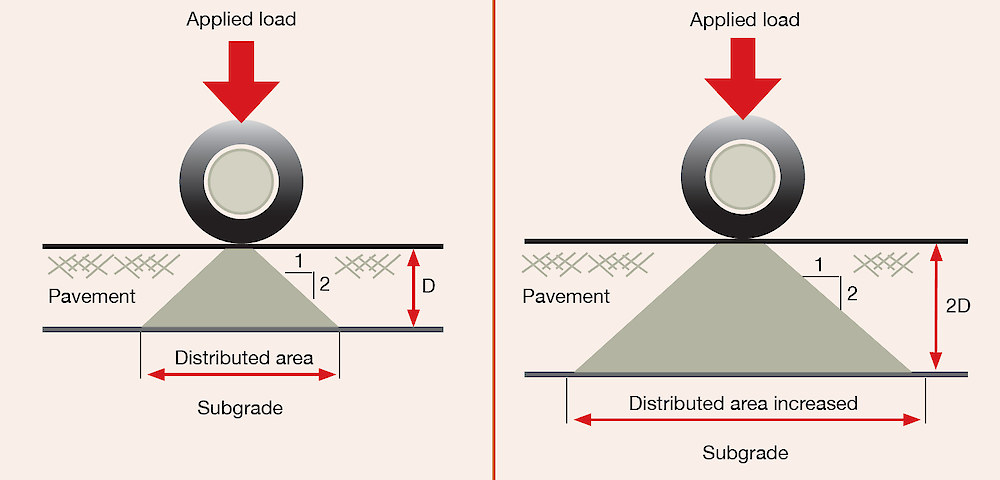A thicker pavement attributes stress over a larger area
Knowing both the designed traffic loading, in terms of equivalent standard axles (ESA), and the Californian bearing ratio value for the subgrade, means that design charts can be used to provide an indication of pavement depth requirements. A thicker pavement layer distributes stress over a larger area, enabling the subgrade to withstand larger loads.
The standard chart used for public road design has two shortcomings for forest roads. It is based on very high volumes of traffic in excess of 10,000 ESA, requires a pavement with minimum CBR of 80%, and provides a 90% confidence that the road will not fail in its design life (ARRB 2010). Traffic will be less for most forest roads and the pavement material will be weaker (CBR approximately 40%). Also, 80% confidence is considered fit for purpose for forest roads. Small failures, such as rutting, can be readily remedied through maintenance and will not stop typical forestry traffic. As such, the chart presented in the ARPG report (1998) is most suitable for forest road design.
Example: CBR design chart
A subgrade soil for a new forest road has been assessed to have a saturated strength of CBR=5. Saturated strength has been used as the road is planned for use during the wet season. The design ESA is 35,000 (from previous example). Enter the graph at ESA=3.5 x 104 and draw a line vertically until the CBR=5 line is intercepted. Draw a second line horizontally from this point to intercept with the horizontal axis. The resulting value on the horizontal axis is the required pavement depth. For this example, a minimum compacted pavement depth of 200 mm would be required.
CBR versus pavement thickness Source: Guide to the design of new pavements for light traffic, APRG Report 21, 1998
Source: Guide to the design of new pavements for light traffic, APRG Report 21, 1998
Central tyre inflation (CTI)
 Central tyre inflation on the drive wheelsCentral tyre inflation (CTI) assists truck performance on forest roads through improved gradient, traction and handling. CTI also helps to maintain the pavement. In critical areas with steep adverse roads or poor pavement properties, roads may need to be designed solely for CTI trucks.
Central tyre inflation on the drive wheelsCentral tyre inflation (CTI) assists truck performance on forest roads through improved gradient, traction and handling. CTI also helps to maintain the pavement. In critical areas with steep adverse roads or poor pavement properties, roads may need to be designed solely for CTI trucks.